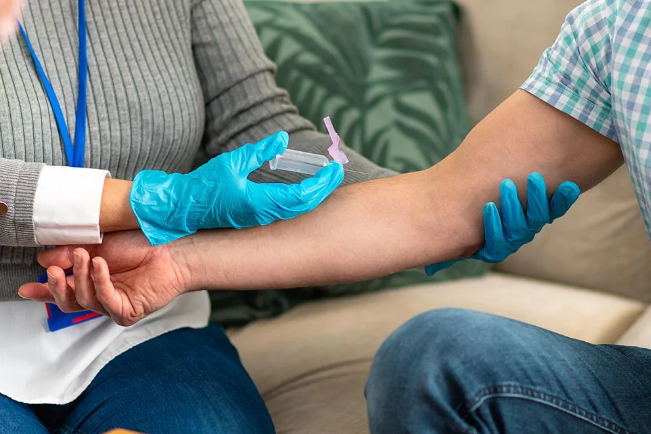Homocysteine is a kind of amino corrosive that is available in the body. At the point when levels are excessively high, it very well may be an indication of a few medical problems going from coronary illness to stroke. Thusly, you can have a homocysteine test to check for coronary illness. Peruse underneath to become familiar with the arrangement and strategy for this test.

What is a homocysteine level test?
Homocysteine is one of 20 kinds of amino acids tracked down in the body and blood. These amino acids are delivered when the body separates protein. At the point when the body needs to recover protein, the principal parts required are amino acids.
Homocysteine is a fundamental amino corrosive that the body can’t deliver itself. Along these lines, you want to get your admission from your everyday eating regimen, particularly high-protein food sources like meat, fish, and milk.
You additionally need to take nutrients B6, B9, and B12 as these nutrients assist with separating amino acids in the body. This cycle produces different substances that the body needs and leaves a modest quantity of homocysteine in the circulation system.
High homocysteine levels can harm conduits. This condition, known as homocysteinemia, can likewise show various medical issues, like nutrient inadequacies, heart issues, and stroke. To see whether you have homocysteinemia, you want to have a homocysteine test. This blood test shows how high the homocysteine level is in your blood.
What is the homocysteine level test for?
Specialists by and large suggest testing homocysteine levels in individuals who have side effects of vitamin B12 as well as folate (nutrient B9) lack. This condition normally causes side effects that are challenging to recognize, so patients need to go through tests.
Individuals with beginning phase B lack of nutrients can step through the exam without first appearance side effects. In the meantime, many likewise go through tests in the wake of encountering side effects, for example,
- loose bowels,
- mixed up,
- pale,
- the body is dormant and powerless,
- loss of hunger,
- palpitations,
- windedness,
- sore mouth and tongue, and
- Shivering, deadness, or consuming in the hands or feet.
Your PCP may likewise recommend testing homocysteine levels to decide if you are so defenseless to cardiovascular (heart and vein) sickness. This test is much of the time expected in the treatment of strokes and respiratory failures.
In specific cases, specialists utilize this test to analyze homocystinuria in babies. This is an uncommon hereditary condition that upsets the breakdown of proteins in the body, causing blood levels of amino acids to rise.
What would it be advisable for you to be aware of before going through this assessment?
Various elements can increment homocysteine levels in the blood. A portion of these is orientation, age, smoking propensities, and utilization of medications like carbamazepine, methotrexate, and phenytoin. If your relative is determined to have homocystinuria, the person should go through additional hereditary testing. The point of this study is to recognize quality changes that lead to expanded amino corrosive levels in the pee.
What would it be a good idea for you to plan?
Before the assessment, converse with your PCP about the planning, technique, dangers, and meaning of the assessment results. Ensure you figure out all that and make it a point to your primary care physician. You might have to cease eating, drinking (other than water), and taking the drug for eight hours before the test. Enlighten your primary care physician regarding all medicine and nonprescription meds you take consistently.
What is the strategy for testing homocysteine levels?
A blood test is expected for an amino basic analysis. Before the blood is drawn, the clinical staff will clean a little region on your arm with a germ-free arrangement. Then, at that point, he will tie a versatile belt around your arm. The paramedic will then, at that point, embed a clean needle into your arm. Your blood streams into a little cylinder associated with the needle. After the blood has gathered, the sterile needle will be taken out from your arm. You can continue your typical exercises once the test is finished. The clinical staff will tell you when you can get the experimental outcome and will clear up it for you at your next arrangement.
What do your experimental outcomes mean?
The typical worth reaches recorded here are rules as it were. Every clinic or research center might have an alternate scope of typical qualities. Consequently, your experimental outcomes connect with the norm to which you were tried. Specialists can likewise assess the experimental outcomes because of your ailment and different variables. This implies values outside the ordinary reach recorded here might be typical for the lab you are visiting.
Toward the beginning of the College of Rochester Clinical Center site, typical homocysteine levels are under 15 micromoles per liter of blood (mcmol/L). The following are various qualities that ought to be delegated high.
- Medium: 15 – 30 mcmol/L
- Medium: 30 – 100 mcmol/l
- Serious: more than 100 mcmol/l
Here are a few circumstances that can increment amino corrosive levels in your blood.
- Too little folic corrosive, vitamin B6, or vitamin B12.
- Different circumstances or infections, for example, homocystinuria, kidney illness, hypothyroidism, Alzheimer’s sickness, or certain malignant growths.
- A lot of liquor.
- Male orientation.
- Expanding age.
Test results may likewise show low levels related to taking nutrient enhancements or certain meds. Your primary care physician will examine with you any strange experimental outcomes connected with your clinical history.
